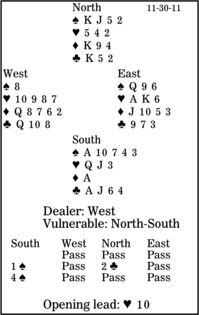Bridge column, November 30: A second chance to take tricks

There are 100 intermediate, advanced and advanced, plus declarer-play problems. This deal is from the middle bracket. South is in four spades. West leads the heart 10. East takes the first two tricks with top hearts, then plays a third round to South's queen. How should declarer continue?
North's two-club response was Reverse Drury-Fit. It showed a maximum pass with at least three-card spade support. (Drury is a recommended convention.)
At first glance, declarer needs to play either spades or clubs without loss. Taking each suit in isolation, in spades it is fractionally better to play off the ace and king; in clubs, though, it is much better to finesse on the second round. But as you can see, if South plays that way, he will go down and, no doubt, grumble about his bad luck.
Assuming the breaks are reasonable, the contract is a certainty. Declarer should cash his diamond ace, play a spade to dummy's king, take the diamond king (discarding a club from his hand), and ruff the last diamond in his hand. South returns to dummy with a club and calls for a trump. When East follows low, declarer finesses his 10. Here, the finesse wins and the contract is home. But if West could take the trick, he would be endplayed, forced either to lead into South's ace-jack of clubs or concede a ruff-and-sluff.
To order, go to www.kantarbridge.com.
** ** **
COPYRIGHT 2011, UNITED FEATURE SYNDICATE
DISTRIBUTED BY UNIVERSAL UCLICK FOR UFS

